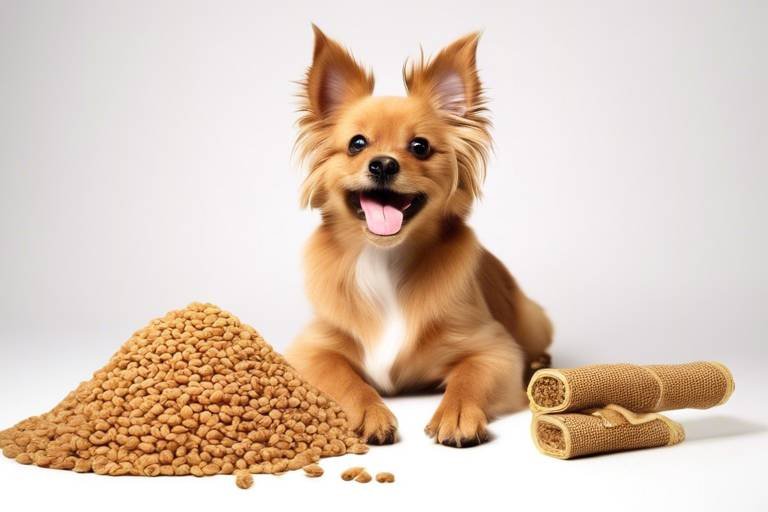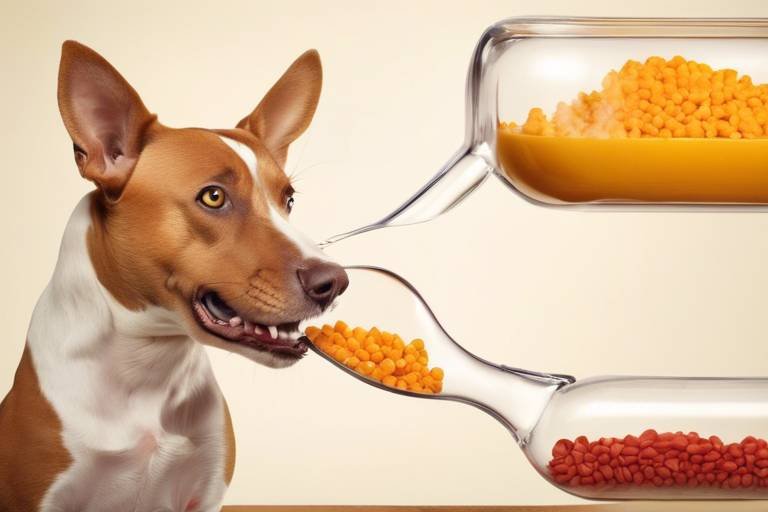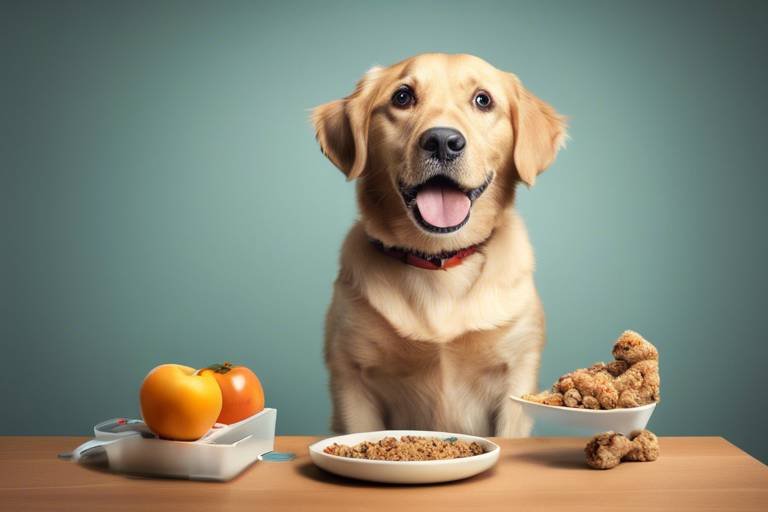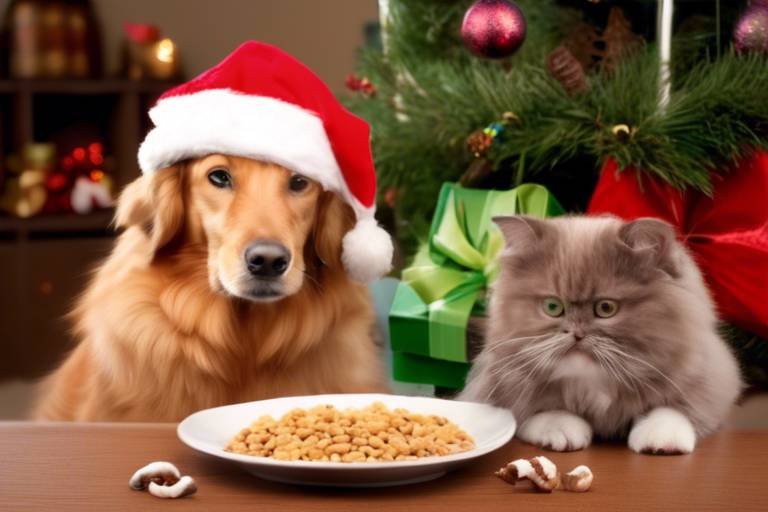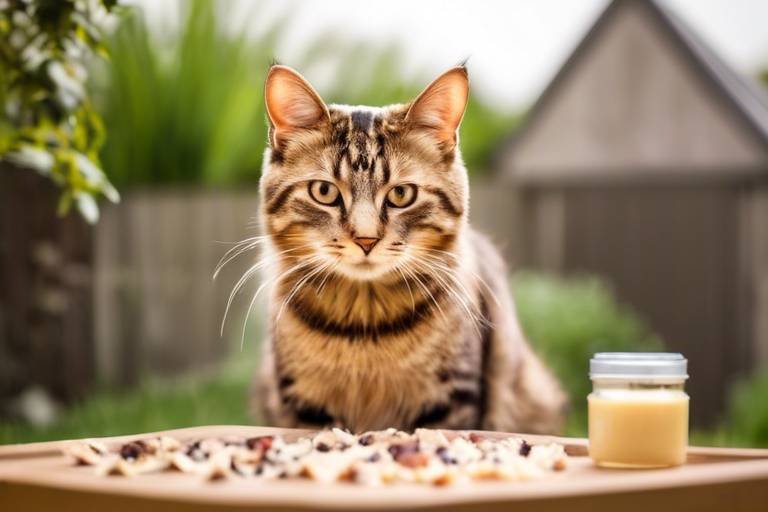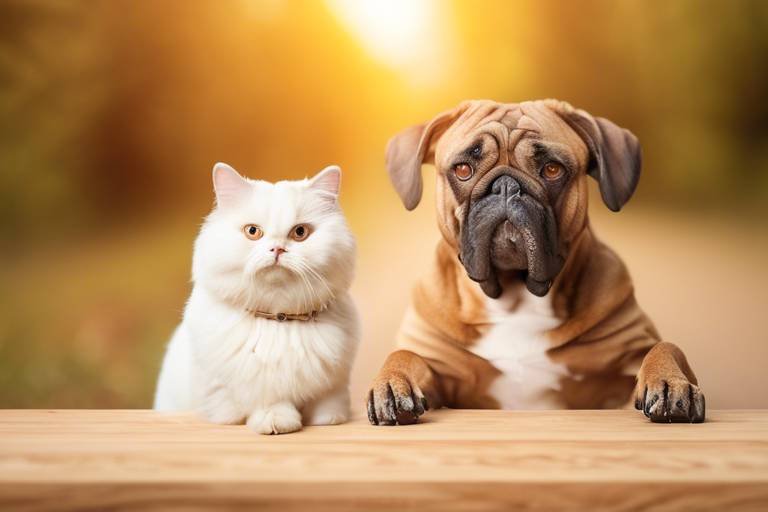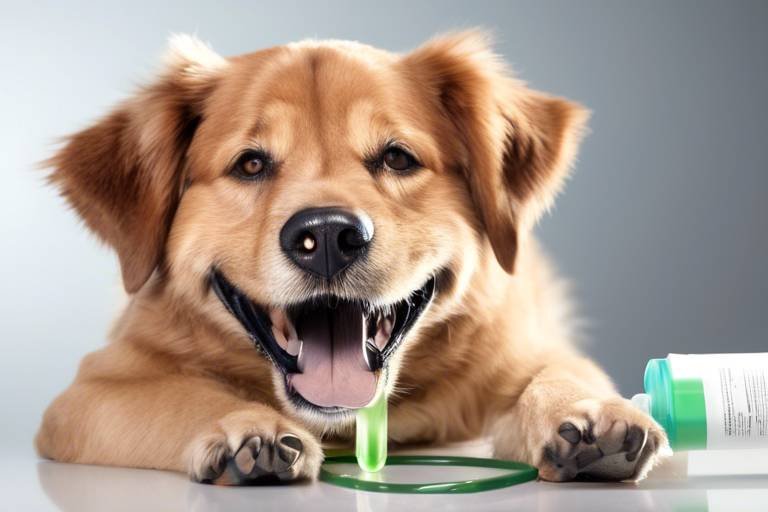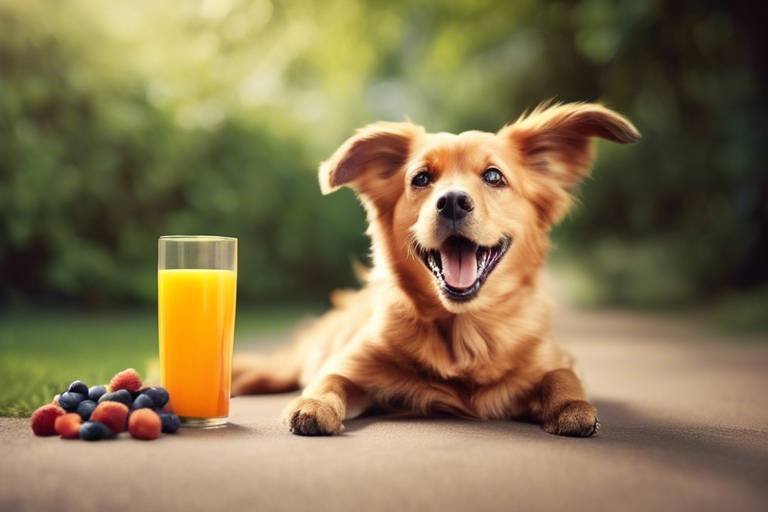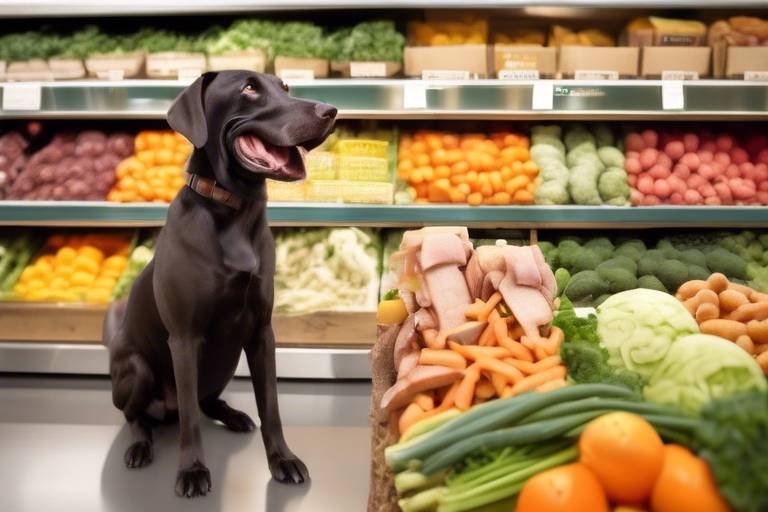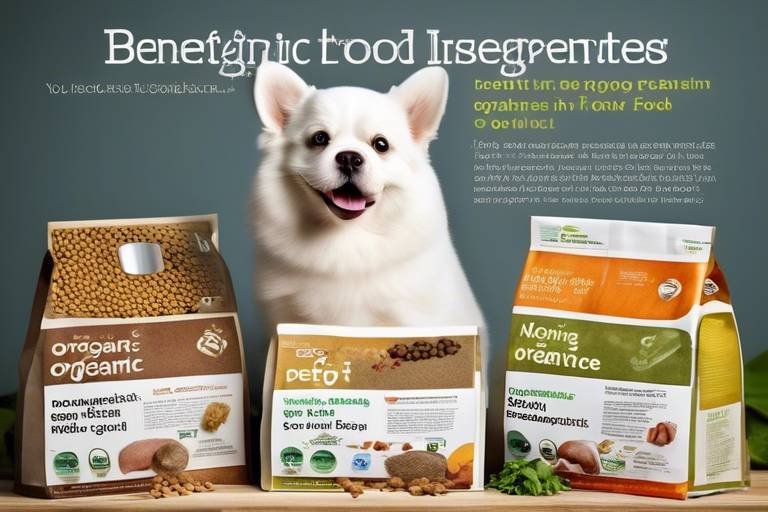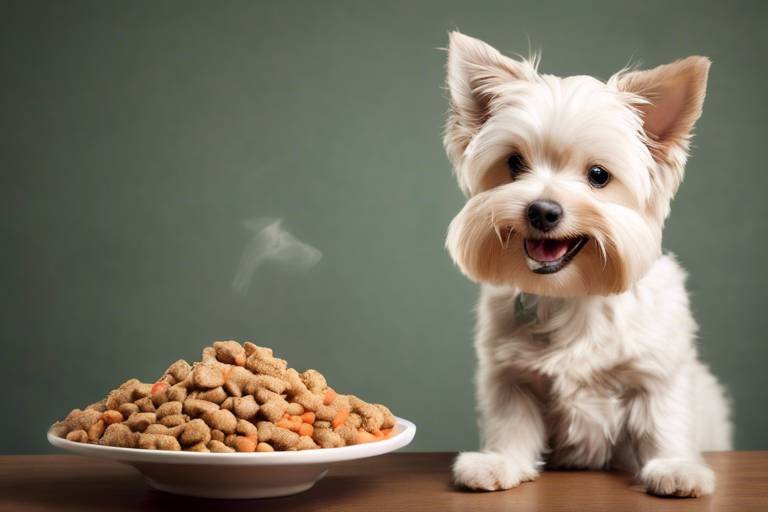The Importance of Fiber in Your Pet's Diet
Have you ever wondered why your furry friend seems to have a never-ending appetite, yet struggles with their weight? Or perhaps you’ve noticed that they occasionally have trouble in the bathroom department? Well, the answer might just lie in one of the most underrated nutrients in their diet: fiber. Fiber is not just a buzzword; it’s a crucial component that can significantly impact your pet's health, from digestion to weight management and beyond. Just like humans, pets need a balanced diet, and fiber plays a pivotal role in achieving that balance.
In this article, we’ll dive deep into the world of fiber, exploring its types, benefits, and how you can ensure your pet is getting enough of it. Think of fiber as the unsung hero of your pet's diet—often overlooked but incredibly important. So, let’s unravel the mystery of fiber and understand how it can enhance your pet's overall well-being!
Fiber is a vital nutrient that aids in digestion and promotes gut health in pets. It’s the part of plant-based foods that the body can't digest, but that doesn’t mean it’s useless. In fact, fiber comes in various forms, and each type has specific functions in a pet's diet. It’s like a multi-tool for your pet’s digestive system, helping to regulate everything from bowel movements to nutrient absorption.
There are two primary types of fiber: soluble and insoluble. Soluble fiber dissolves in water and forms a gel-like substance, which can help slow down digestion and regulate blood sugar levels. On the other hand, insoluble fiber adds bulk to your pet's stool and helps food pass more quickly through the digestive tract. Both types are essential, and they work together to keep your pet's digestive system running smoothly.
Including fiber in your pet's diet offers numerous health benefits that go beyond just keeping them regular. For starters, fiber is a natural way to improve digestion. It helps maintain a healthy gut environment, which is crucial for nutrient absorption. When your pet’s digestive system is functioning well, they’re more likely to get the most out of their food, leading to better overall health.
Let’s talk about digestive health because this is where fiber truly shines. Fiber plays a significant role in maintaining a healthy digestive system. It helps regulate bowel movements, preventing issues like constipation and diarrhea. Imagine fiber as a gentle broom that sweeps through your pet's intestines, ensuring everything stays clean and orderly. When your pet consumes enough fiber, they are less likely to experience digestive discomfort.
As mentioned earlier, fiber can be classified into two main types: soluble and insoluble. Here’s a quick comparison:
| Type of Fiber | Characteristics | Benefits |
|---|---|---|
| Soluble Fiber | Dissolves in water, forms a gel-like substance | Helps regulate blood sugar, slows digestion |
| Insoluble Fiber | Does not dissolve in water, adds bulk to stool | Prevents constipation, promotes regular bowel movements |
Another important player in the fiber game is prebiotic fiber. This type of fiber fosters beneficial gut bacteria, promoting overall gut health. Prebiotics act as food for these good bacteria, helping them thrive and keep your pet’s gut environment healthy. It’s like giving your pet’s gut a little party, where the good bacteria can flourish and do their job effectively!
Now, let’s discuss how fiber can be an effective tool for weight management in pets. If your pet is prone to weight gain, incorporating more fiber into their diet can help them feel fuller without adding extra calories. Think of fiber as a natural appetite suppressant. When your pet eats fiber-rich foods, they’re likely to eat less overall, which can lead to healthier weight levels.
So, how do you make sure your pet is getting enough fiber? Well, selecting appropriate fiber sources for your pet's diet is essential. There are various fiber-rich foods and supplements that can be safely included in their meals. Natural foods like fruits, vegetables, and whole grains are excellent sources of fiber. Just imagine adding a colorful mix of veggies to your pet's bowl—it's not only nutritious but also visually appealing!
Fruits and vegetables are fantastic natural sources of fiber. Here are some fiber-rich options you can consider:
- Carrots
- Pumpkin
- Green beans
- Apples (without seeds)
- Sweet potatoes
Incorporating these foods into your pet's diet can be as easy as mixing them into their regular meals or offering them as treats. Just remember to introduce new foods gradually to avoid any digestive upset.
For pets needing additional fiber, commercial supplements can be beneficial. There are various types of fiber supplements available, including powders, capsules, and treats. Always consult your veterinarian before adding supplements to your pet's diet to ensure they’re appropriate for your pet's specific needs.
1. How much fiber does my pet need?
The amount of fiber needed can vary based on your pet’s age, size, and health condition. Generally, a diet containing 2-5% fiber is recommended for dogs and around 1-3% for cats.
2. Can too much fiber be harmful?
Yes, excessive fiber can lead to digestive issues such as bloating or diarrhea. It’s important to find the right balance.
3. What are signs my pet needs more fiber?
Signs may include constipation, irregular bowel movements, or excessive hunger. If you notice these issues, consult your vet.
4. Are there any fiber-rich commercial pet foods?
Yes, many brands offer high-fiber diets. Look for options that list whole grains, fruits, or vegetables among the first ingredients.
In conclusion, fiber is an essential nutrient that can significantly improve your pet's health and well-being. By understanding its importance and ensuring your pet gets the right amount of fiber, you can help them lead a happier, healthier life.

Understanding Fiber
When we talk about fiber, we often think of it as a simple nutrient that helps with digestion. However, fiber is so much more than that; it's a vital component of your pet's diet that can significantly impact their overall health. Just like humans, pets require fiber to maintain a healthy digestive system, and understanding the different types of fiber is essential for every pet owner.
Fiber is primarily classified into two categories: soluble fiber and insoluble fiber. Each type plays a unique role in digestion and overall health. Soluble fiber dissolves in water and forms a gel-like substance in the intestines. This type of fiber can help manage blood sugar levels and lower cholesterol, making it an excellent choice for pets with specific health concerns. On the other hand, insoluble fiber does not dissolve in water. Instead, it adds bulk to the stool and helps food pass through the digestive tract more efficiently. This is particularly beneficial for preventing constipation and promoting regular bowel movements.
To give you a clearer picture, here's a quick comparison of the two types of fiber:
| Type of Fiber | Characteristics | Health Benefits |
|---|---|---|
| Soluble Fiber | Dissolves in water, forms a gel-like substance | Helps control blood sugar, lowers cholesterol levels |
| Insoluble Fiber | Does not dissolve in water, adds bulk to stool | Prevents constipation, promotes regular bowel movements |
Additionally, prebiotic fiber is another essential component that deserves mention. This type of fiber acts as food for the beneficial bacteria in your pet's gut. By fostering the growth of these good bacteria, prebiotic fiber enhances gut health and boosts the immune system. Think of prebiotic fiber as the fertilizer for your pet's gut garden, helping it thrive and flourish.
Incorporating fiber into your pet's diet can be as simple as adding fruits and vegetables. Foods like pumpkin, carrots, and apples are not only tasty but also packed with fiber. However, it’s essential to introduce fiber gradually to avoid digestive upset. Just like us, pets can experience discomfort if their diet changes too quickly.
In summary, understanding fiber and its types is crucial for maintaining your pet's health. It’s not just about preventing constipation; it's about ensuring that your furry friend has a well-rounded diet that supports their overall well-being. So, the next time you’re at the pet store or preparing meals for your pet, remember the importance of fiber and make informed choices to keep them happy and healthy!

Benefits of Fiber
Including fiber in your pet's diet is not just a good idea; it’s a game changer! Imagine your pet feeling energetic, happy, and healthy—fiber can help make that happen. The benefits of fiber go beyond just keeping your furry friend regular. It's like a superhero for their digestive system, offering a multitude of health advantages that can enhance their overall well-being.
First and foremost, fiber is essential for improved digestion. It acts like a broom, sweeping through the intestines and helping to keep everything moving smoothly. This is particularly important for pets who may struggle with constipation. When fiber is present in their diet, it can help regulate bowel movements, ensuring that your pet doesn’t experience discomfort or digestive distress. Just think of fiber as a friendly helper that keeps your pet’s gut in tip-top shape!
Another significant benefit of fiber is its role in weight management. If your pet is on the heavier side, adding more fiber to their meals can help them feel fuller without adding extra calories. This is because fiber takes longer to digest, which means your pet will feel satisfied for a longer period. It’s like filling up a balloon with air; the more you add, the bigger it gets! This can be especially useful for pets who are prone to overeating or those who need to shed a few pounds.
Moreover, fiber can enhance nutrient absorption. When your pet consumes a balanced diet rich in fiber, it helps the body efficiently absorb essential nutrients. Think of it as a team of workers in a factory—fiber ensures that all the important nutrients are getting to where they need to go. This is crucial for your pet’s overall health, as it supports their immune system and keeps their energy levels up.
To sum it up, the benefits of fiber in your pet's diet include:
- Improved Digestion: Helps regulate bowel movements and prevent constipation.
- Weight Management: Keeps pets feeling fuller, reducing calorie intake.
- Enhanced Nutrient Absorption: Supports overall health by ensuring nutrients are effectively utilized.
So, if you want to see your pet thrive, consider incorporating fiber into their meals. It’s a simple yet effective way to promote their health and happiness!
Q: How much fiber should my pet have in their diet?
A: The amount of fiber can vary based on your pet's size, age, and health condition. Generally, a diet containing 2-5% fiber is suitable for most pets. However, it’s best to consult your veterinarian for personalized advice.
Q: Can too much fiber be harmful to my pet?
A: Yes, while fiber is beneficial, too much can lead to digestive upset, such as gas or diarrhea. Balance is key, so make sure to introduce fiber gradually and monitor your pet's response.
Q: What are some good sources of fiber for pets?
A: Excellent sources of fiber include fruits like apples and blueberries, vegetables like carrots and peas, and whole grains such as brown rice and oats. Always ensure these foods are safe for your specific pet before introducing them.
Digestive Health
When it comes to our pets, their digestive health is just as crucial as any other aspect of their well-being. Think of your pet's digestive system as a finely tuned engine; if one part isn't working right, the whole thing can sputter and stall. That's where fiber comes into play. It acts like a natural broom, sweeping through the intestines and ensuring everything runs smoothly. By including adequate fiber in your pet's diet, you're not just preventing constipation; you're also promoting a balanced gut environment that can help stave off various digestive issues.
Imagine your pet's digestive tract as a bustling highway. Without fiber, traffic can get backed up, leading to discomfort and even health problems. Fiber helps regulate bowel movements by adding bulk to the stool, which makes it easier to pass. This is especially important for pets that may be prone to constipation or irregular bowel habits. In fact, studies have shown that pets who consume sufficient fiber tend to have more consistent and healthier bowel movements. So, if you notice your furry friend straining during bathroom breaks, it might be time to consider boosting their fiber intake!
Moreover, fiber doesn't just stop at aiding in regularity; it also plays a significant role in fostering a healthy gut microbiome. A diverse population of beneficial bacteria in the gut can enhance nutrient absorption and improve overall health. Fiber acts as a food source for these good bacteria, promoting their growth and activity. Think of it as providing a feast for your pet's gut buddies, which in turn helps them keep everything else in check.
Now, you might be wondering, what types of fiber are best for digestive health? Generally, they fall into two categories: soluble fiber and insoluble fiber. Soluble fiber dissolves in water and forms a gel-like substance, which can help slow digestion and stabilize blood sugar levels. On the other hand, insoluble fiber adds bulk to the stool and helps food pass more quickly through the stomach and intestines. Both types are essential, and a balanced diet should include a mix of both to optimize digestive health.
To give you a clearer picture, here’s a quick comparison of the two types of fiber:
| Type of Fiber | Characteristics | Benefits |
|---|---|---|
| Soluble Fiber | Dissolves in water, forms a gel-like substance | Helps regulate blood sugar, slows digestion |
| Insoluble Fiber | Does not dissolve in water, adds bulk to stool | Promotes regular bowel movements, prevents constipation |
In conclusion, ensuring your pet gets enough fiber is a simple yet powerful way to promote digestive health. It’s not just about keeping things moving; it’s about creating a thriving environment for gut bacteria and enhancing nutrient absorption. So, the next time you’re choosing food for your furry friend, remember that a little fiber can go a long way!
- How much fiber does my pet need? The amount of fiber varies by species and individual needs, but generally, 2-5% of their diet should come from fiber sources.
- Can too much fiber be harmful? Yes, excessive fiber can lead to digestive issues like diarrhea or bloating. It's essential to find a balance.
- What are the best natural sources of fiber for pets? Fruits, vegetables, and whole grains are excellent sources. Pumpkin, sweet potatoes, and green beans are particularly beneficial.
- Are fiber supplements safe for pets? Yes, but consult your veterinarian before introducing any supplements to ensure they are appropriate for your pet's specific health needs.
Types of Fiber
When it comes to the types of fiber that can benefit your furry friend, it’s essential to understand that not all fiber is created equal. Broadly speaking, there are two main categories of fiber: soluble fiber and insoluble fiber. Each type plays a unique role in your pet's digestive health and overall well-being. Let's dive deeper into these fiber types and see how they affect your pet's diet.
Soluble fiber dissolves in water and forms a gel-like substance in the stomach. This type of fiber is particularly beneficial for pets that may struggle with digestion. It can help slow down the digestive process, which allows for better nutrient absorption. Foods rich in soluble fiber include oats, barley, and certain fruits like apples and bananas. Incorporating these foods can help regulate blood sugar levels and keep your pet feeling full longer.
On the other hand, insoluble fiber does not dissolve in water. Instead, it adds bulk to your pet's stool and aids in moving food through the digestive tract. This is crucial for maintaining regular bowel movements and preventing constipation. You can find insoluble fiber in whole grains, nuts, and the skins of many fruits and vegetables. Think of it as the broom of the digestive system, sweeping away waste and keeping everything running smoothly.
To give you a clearer picture of how these fibers differ, here's a quick comparison:
| Type of Fiber | Characteristics | Benefits |
|---|---|---|
| Soluble Fiber | Dissolves in water, forms a gel-like substance | Helps with nutrient absorption, regulates blood sugar |
| Insoluble Fiber | Does not dissolve in water, adds bulk to stool | Aids in digestion, prevents constipation |
Both types of fiber are vital for your pet’s diet, and they often work best when combined. Think of fiber as a dynamic duo that keeps your pet's digestive system in tip-top shape. Just as we need a balanced diet, our pets thrive on a mix of soluble and insoluble fibers to maintain their health and vitality.
In summary, understanding the types of fiber and their specific roles can empower you to make informed decisions about your pet's diet. Whether you opt for natural sources like fruits and vegetables or consider supplements, ensuring a balanced intake of both soluble and insoluble fiber will pave the way for a healthier, happier pet.
- What are some good sources of soluble fiber for pets? Foods like oats, apples, and carrots are great options.
- How can I tell if my pet needs more fiber? Signs include irregular bowel movements or excessive weight gain.
- Can too much fiber be harmful? Yes, excessive fiber can lead to digestive issues, so moderation is key.
Prebiotic Fiber
When it comes to your pet's diet, is like the unsung hero of the nutritional world. It’s not just any fiber; it’s the kind that actively works to foster a thriving community of beneficial bacteria in your pet’s gut. Imagine your pet's digestive system as a bustling city, where good bacteria are the friendly neighbors keeping everything in order. Prebiotic fiber serves as the food that keeps these neighbors happy and well-fed, ensuring that they can do their job effectively.
So, what exactly is prebiotic fiber? In simple terms, it’s a type of soluble fiber that your pet cannot digest. Instead, it passes through the gastrointestinal tract and becomes a feast for the good bacteria in the intestines. This process not only supports the growth of these beneficial bacteria but also helps to inhibit the growth of harmful bacteria, creating a balanced gut microbiome. A healthy gut is crucial for your pet's overall health, as it plays a significant role in digestion, immune function, and even mood regulation.
Including prebiotic fiber in your pet's diet can lead to a multitude of benefits. For instance, it can enhance nutrient absorption, ensuring that your furry friend gets the most out of their food. Additionally, it helps regulate bowel movements, making them more consistent and reducing the risk of constipation. This is particularly important for pets that may struggle with digestive issues. Furthermore, a balanced gut microbiome can lead to improved immune function, meaning your pet may be less prone to infections and illnesses.
But where can you find this magical prebiotic fiber? Here’s a quick rundown of some excellent sources:
- Chicory Root: Often found in commercial pet foods, chicory root is rich in inulin, a type of prebiotic fiber.
- Beet Pulp: This common ingredient in pet foods not only provides fiber but also acts as a prebiotic.
- Apple Pulp: Apples, when included in moderation, can offer both soluble fiber and prebiotics.
- Oats: Cooked oats can be a great addition to your pet's diet, providing a good source of soluble fiber.
Incorporating these foods into your pet's meals can be as simple as adding a spoonful of cooked oats or finely chopped apples to their regular food. However, it’s essential to introduce any new foods gradually to avoid upsetting their stomach. Always consult with your veterinarian before making significant changes to your pet's diet, especially if they have existing health conditions.
In conclusion, prebiotic fiber is an essential component of your pet's diet that supports gut health, enhances nutrient absorption, and contributes to overall well-being. Just like a well-tended garden, a healthy gut requires the right nutrients to flourish, and prebiotic fiber is a key ingredient in that mix.
1. What are prebiotics and probiotics?
Prebiotics are non-digestible fibers that promote the growth of beneficial bacteria in the gut. Probiotics, on the other hand, are live bacteria that provide health benefits when consumed. Together, they help maintain a balanced gut microbiome.
2. Can I give my pet prebiotic supplements?
Yes, there are various prebiotic supplements available for pets. However, it's best to consult your veterinarian before introducing any supplements to ensure they are appropriate for your pet's specific needs.
3. How can I tell if my pet needs more fiber in their diet?
Signs that your pet may need more fiber include irregular bowel movements, constipation, or excessive weight gain. If you notice these signs, consult your veterinarian for dietary recommendations.
4. Are there any side effects of too much fiber?
While fiber is essential, too much of it can lead to digestive upset, including gas, bloating, or diarrhea. It's important to introduce fiber gradually and monitor your pet's response.
Weight Management
When it comes to keeping our furry friends healthy, weight management is a topic that often gets overlooked. Just like humans, pets can struggle with maintaining a healthy weight, which can lead to a whole host of health issues, from diabetes to joint problems. One of the most effective tools in managing your pet's weight is incorporating fiber into their diet. But how does fiber help? Well, let’s break it down!
Fiber acts like a sponge in your pet’s digestive system. It absorbs water and expands, which helps your pet feel full without adding extra calories. Imagine filling a balloon with air versus filling it with water; the balloon filled with water is much heavier and takes up more space, right? Similarly, fiber-rich foods can help your pet feel satisfied while consuming fewer calories. This is particularly beneficial for pets that tend to overeat or are less active.
Additionally, fiber slows down the digestion of food, which means that nutrients are absorbed more gradually. This not only helps in controlling blood sugar levels but also keeps your pet feeling full longer. So, if your pet is on a weight loss journey, incorporating fiber can be a game changer. It’s like giving them a little extra cushion in their meals, allowing them to enjoy their food while still sticking to their calorie limits.
But not all fibers are created equal! When choosing fiber sources for your pet, it’s essential to consider both soluble and insoluble fibers. Soluble fiber, found in foods like oats and peas, dissolves in water and can help lower cholesterol levels. On the other hand, insoluble fiber, which you’ll find in whole grains and vegetables, adds bulk to your pet’s stool and helps keep their digestive system moving smoothly.
Here’s a quick comparison table to illustrate the differences:
| Type of Fiber | Sources | Benefits |
|---|---|---|
| Soluble Fiber | Oats, Peas, Apples | Helps lower cholesterol, slows digestion |
| Insoluble Fiber | Whole Grains, Vegetables, Nuts | Adds bulk to stool, aids in regular bowel movements |
Incorporating these fibers into your pet's diet doesn’t have to be complicated. You can start by adding small amounts of fruits and vegetables to their meals or opting for high-fiber pet food. Just remember, moderation is key! Too much fiber can lead to digestive upset, so it's best to introduce any new food gradually.
Ultimately, fiber is not just a filler; it’s a powerful ally in your pet's weight management journey. By making informed choices about their diet, you can help your pet maintain a healthy weight, improve their overall well-being, and ensure they live a long, happy life. After all, a healthy pet is a happy pet!
- How much fiber does my pet need? The amount of fiber your pet needs can vary based on their size, age, and health status. Generally, a diet containing 2-5% fiber is sufficient for most pets.
- Can I give my pet human food for fiber? Yes, many fruits and vegetables are safe for pets. Just make sure to avoid toxic foods like grapes, onions, and garlic.
- What are signs that my pet needs more fiber? If your pet is experiencing constipation, weight gain, or digestive issues, it may be time to increase their fiber intake.

Choosing the Right Fiber Sources
When it comes to your pet's diet, is crucial for their health and well-being. Not all fibers are created equal, and understanding which sources will best benefit your furry friend can make a significant difference in their overall health. Just like humans, pets require a balanced diet that includes the right types of fiber to promote optimal digestion and maintain a healthy weight. So, how do you go about selecting the best fiber sources?
First, it's important to consider natural fiber sources. These are often the best options because they come packed with essential nutrients that can boost your pet's health. Foods like fruits, vegetables, and whole grains are excellent choices. For instance, pumpkin is not only rich in fiber but also helps with digestion, making it a fantastic addition to your pet's meals. Similarly, green beans and carrots can add a crunch that pets love while providing necessary fiber.
However, if your pet is a picky eater or if you find it challenging to incorporate enough natural fiber into their diet, you might consider commercial fiber supplements. These can be particularly beneficial for pets with specific health issues that require additional fiber. There are various types of fiber supplements available, such as:
- Psyllium Husk: A soluble fiber that can help regulate bowel movements.
- Inulin: A prebiotic fiber that promotes healthy gut bacteria.
- Beet Pulp: A source of both soluble and insoluble fiber, great for digestive health.
When selecting a fiber supplement, it's essential to read the labels carefully and consult with your veterinarian to ensure that it is appropriate for your pet's specific needs. Just like with any other dietary change, introducing fiber should be done gradually. This helps your pet's digestive system adjust without any unwanted side effects.
In summary, whether you opt for natural fiber sources or commercial supplements, the key is to ensure that your pet's fiber intake is balanced and tailored to their individual health needs. Remember, a well-fibered diet can lead to a happier, healthier pet, and who doesn't want that? So next time you're at the pet store or the grocery aisle, keep an eye out for those fiber-rich options that can make a world of difference in your pet's life.
Q: How much fiber does my pet need?
A: The amount of fiber varies by species and individual health needs. Generally, dogs require about 2-5% fiber in their diet, while cats need about 1-2%. Consult your vet for personalized advice.
Q: Can too much fiber be harmful?
A: Yes, excessive fiber can lead to digestive issues such as gas or diarrhea. It's essential to introduce fiber gradually and monitor your pet's response.
Q: Are there any fiber sources I should avoid?
A: Certain foods, like onions and garlic, are toxic to pets and should be avoided. Always research or consult your veterinarian before introducing new foods.
Natural Fiber Sources
When it comes to ensuring your pet gets the right amount of fiber, selecting natural sources is a fantastic approach. Not only do these foods provide essential nutrients, but they also come packed with flavor that your furry friend is sure to love! Think of fiber as the unsung hero in your pet's diet—working quietly behind the scenes to keep everything running smoothly.
So, what are some of the best natural sources of fiber you can introduce into your pet's meals? First up, we have fruits and vegetables. These vibrant foods are not just colorful additions to your pet’s bowl; they are powerhouses of fiber! For instance, carrots, pumpkin, and sweet potatoes are excellent choices. They can be served raw, cooked, or even pureed, depending on your pet's preferences. Just make sure to chop them into manageable pieces to avoid any choking hazards.
Next, let's talk about whole grains. Foods like brown rice, barley, and oats are not only rich in fiber but also provide a hearty source of energy for your pet. Incorporating these grains into their diet can help regulate their digestive system while keeping their energy levels stable throughout the day. Just remember to cook the grains properly, as raw grains can be tough for pets to digest.
Another fantastic natural source is legumes, such as lentils and chickpeas. These little gems are not only fiber-rich but also loaded with protein, making them a great addition to your pet's diet. However, be cautious with portion sizes, as too many legumes can lead to gas and bloating. A little goes a long way!
If you're wondering how to incorporate these fiber sources into your pet's meals, consider mixing them into their regular food. You can create a delicious homemade meal by blending cooked vegetables or grains with their usual protein source. Just like a chef experimenting with flavors, your pet will appreciate the variety!
It's important to introduce these fiber sources gradually. Sudden changes in diet can upset your pet's stomach. Start with small amounts and observe how they react. If they seem to enjoy it and their digestion remains stable, you can slowly increase the quantity. Remember, every pet is unique, and what works for one might not work for another!
In summary, natural fiber sources like fruits, vegetables, whole grains, and legumes can significantly enhance your pet's diet. By incorporating these foods, you're not just adding fiber; you're also enriching their meals with flavor and nutrition. Your pet will thank you for it—just watch as they wag their tail in delight!
- What are some safe fruits and vegetables for pets?
Safe options include carrots, peas, green beans, pumpkin, and apples (without seeds). Always consult your vet before introducing new foods.
- How much fiber should my pet have daily?
The amount of fiber varies by pet size and dietary needs. Generally, dogs need about 2-5% of their diet to be fiber, while cats require about 1-2%. It's best to consult your veterinarian for personalized advice.
- Can too much fiber be harmful?
Yes, excessive fiber can lead to digestive issues such as diarrhea or constipation. It's essential to introduce fiber gradually and monitor your pet's response.
Commercial Fiber Supplements
When it comes to ensuring your pet gets enough fiber, sometimes natural sources just don't cut it. That's where come into play. These supplements can be a lifesaver for pets that have specific dietary needs or those who are picky eaters. They come in various forms, including powders, capsules, and chewables, making it easy to find one that suits your pet's preferences.
Many pet owners wonder why they should consider these supplements. Well, the answer is simple: they can provide a concentrated dose of fiber that may be lacking in your pet's regular diet. For instance, if your furry friend is experiencing digestive issues or if you’re trying to manage their weight, adding a fiber supplement can help bridge that nutritional gap. However, it's essential to choose the right type of supplement to ensure it meets your pet's specific needs.
Here are some popular types of commercial fiber supplements that you might consider:
- Powdered Fiber: These are typically mixed with your pet's food. They can be made from various sources like psyllium husk or beet pulp, offering a versatile option for adding fiber without changing the pet's diet drastically.
- Chewable Tablets: If your pet enjoys treats, chewable fiber tablets can be a fun way to get their daily fiber intake. Just be sure to monitor the quantity to avoid overfeeding.
- Liquid Fiber: Some supplements come in liquid form, making them easy to administer, especially for pets that may not be keen on solid food.
Before you rush out to buy a fiber supplement, it's crucial to consult your veterinarian. They can help you determine the right type and dosage based on your pet's age, weight, and health condition. Overdoing it on fiber can lead to unwanted side effects like gas or bloating, so moderation is key.
Moreover, not all fiber supplements are created equal. Some may contain artificial ingredients or fillers that could do more harm than good. Always opt for high-quality products from reputable brands. Look for supplements that list their ingredients clearly and have a good track record of safety and effectiveness. A quick glance at reviews can also give you insights into how well a product works for other pet owners.
In summary, commercial fiber supplements can be a great addition to your pet's diet, especially if you're struggling to provide enough fiber through food alone. They offer convenience and targeted support for your pet's digestive health, but always remember to approach their use thoughtfully and under veterinary guidance.
Here are some common questions pet owners have about fiber supplements:
- How much fiber does my pet need? The required amount of fiber can vary by species, age, and health conditions. Generally, dogs need about 2-5% fiber in their diet, while cats require around 1-3%.
- Can I give my pet too much fiber? Yes, excessive fiber can lead to digestive issues like bloating and gas. It's crucial to introduce any fiber supplement gradually and monitor your pet's reaction.
- Are there any side effects of fiber supplements? While fiber is generally safe, some pets may experience gastrointestinal upset. Always consult your vet before starting a new supplement.
Frequently Asked Questions
- What is fiber and why is it important for my pet?
Fiber is a crucial nutrient that aids in digestion and promotes gut health in pets. It helps regulate bowel movements, prevents constipation, and plays a key role in overall well-being. Just like humans, pets need fiber to keep their digestive systems running smoothly!
- What are the different types of fiber?
There are two main types of fiber: soluble and insoluble. Soluble fiber dissolves in water and can help lower cholesterol and stabilize blood sugar levels, while insoluble fiber adds bulk to the stool and helps food pass through the digestive tract. Both types are essential for maintaining a healthy gut.
- How does fiber contribute to my pet's digestive health?
Fiber plays a significant role in maintaining a healthy digestive system by regulating bowel movements and preventing constipation. It acts like a broom, sweeping through the intestines and ensuring everything moves along smoothly. This is particularly important for pets that may struggle with digestive issues.
- Can fiber help with weight management in pets?
Absolutely! Fiber can help pets feel fuller for longer, which can reduce their overall calorie intake. When included in their diet, fiber-rich foods can make your pet feel satisfied without packing on the pounds. It's like giving them a hearty meal without the guilt!
- What are some natural sources of fiber I can include in my pet's diet?
Natural sources of fiber include fruits, vegetables, and whole grains. Foods like pumpkin, sweet potatoes, and green beans are excellent choices. Just remember to introduce new foods gradually to avoid any tummy troubles!
- Are there commercial fiber supplements for pets?
Yes, there are various commercial fiber supplements available for pets that can provide an extra fiber boost. These can be beneficial for pets that need additional fiber in their diet, especially if they are experiencing digestive issues. However, it's always best to consult with your veterinarian before starting any new supplement.

